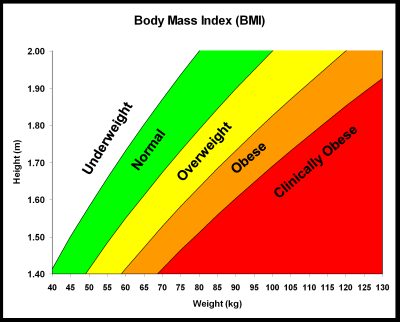When it comes to physical fitness, one often hears that term Body Mass Index or BMI. The BMI is a number that indicates your overall physical condition. This number is based on your height versus your and basically expresses your ideal based on your height. This number does not however take into consideration your overall physical stature or muscle tone.
What does Body Mass Index Measure?

It is important to realize that the body mass index is not a measurement of your percentage of body fat. There is a simple equation that you can use to determine your body mass. This equation is your divided by the square of your height. There is also a chart available that will provide you with a visual way to determine your body mass index.
This chart uses a graph to indicate where your is in conjunction with your height. Along the bottom of the graph is listed typically in pounds and kilograms. Along the side of the chart is your height in both feet and inches, and meters.
The chart is then broken into arched sections that are highlighted by different colors. The various colors indicate different classifications, these classifications include under, Normal, Over, and obese. These categories are then broken into subcategories including mild moderate and severe.
History of BMI
The body mass index ( BMI ) was first created in the 19th century as a formula but was not made popular until the 1970’s. This is considered a relatively reliable way to determine physical condition. However it does have some short comings, it may improperly express your condition based on several factors. If you are elderly than your fat percentage may very well be greater than your body mass index. On the other hand if you are athletic then your body fat percentage may be somewhat lower than your body mass index.
This is particularly true in the case of bodybuilders and lifters. An example of this is that a lifter who is 6 foot tall may well over 260 pounds. The body mass index chart will describe this person as severely obese and be expressed as a 30 on the BMI scale, however this person may have a body fat percentage of less than half of that.
Is the Body Mass Index Good Science?
Overall the body mass index chart and equation is a relatively good guide of a person’s physical condition. You should not however let this replace a professional opinion of your physical condition that can only be determined by a physician during a physical. It is important to remember that if you do feel you are over and the body mass index indicates this as well, then you may want to consider a training program and a modified diet, it is a good idea however to check with your doctor before ever starting a new training regiment or a diet.
–> Body Mass index Calculator <–
Body Mass Index Guidelines
Now that you know the fact here are the numbers. Simply divide you height by your and you will know the number and where you fit in the range.
| Severely under | less than 16.0 |
| Under | from 16.0 to 20.0 |
| Normal | from 20 to 25 |
| Over | from 25 to 30 |
| Obese Class I | from 30 to 35 |
| Obese Class II | from 35 to 40 |
| Obese Class III | over 40 |
Although the body mass index is not the only thing to tell your fitness it is still a really good estimation as to how heavy you are. BMI may seem like a great measurement but when you gain a lot of muscle it is less relevent.


